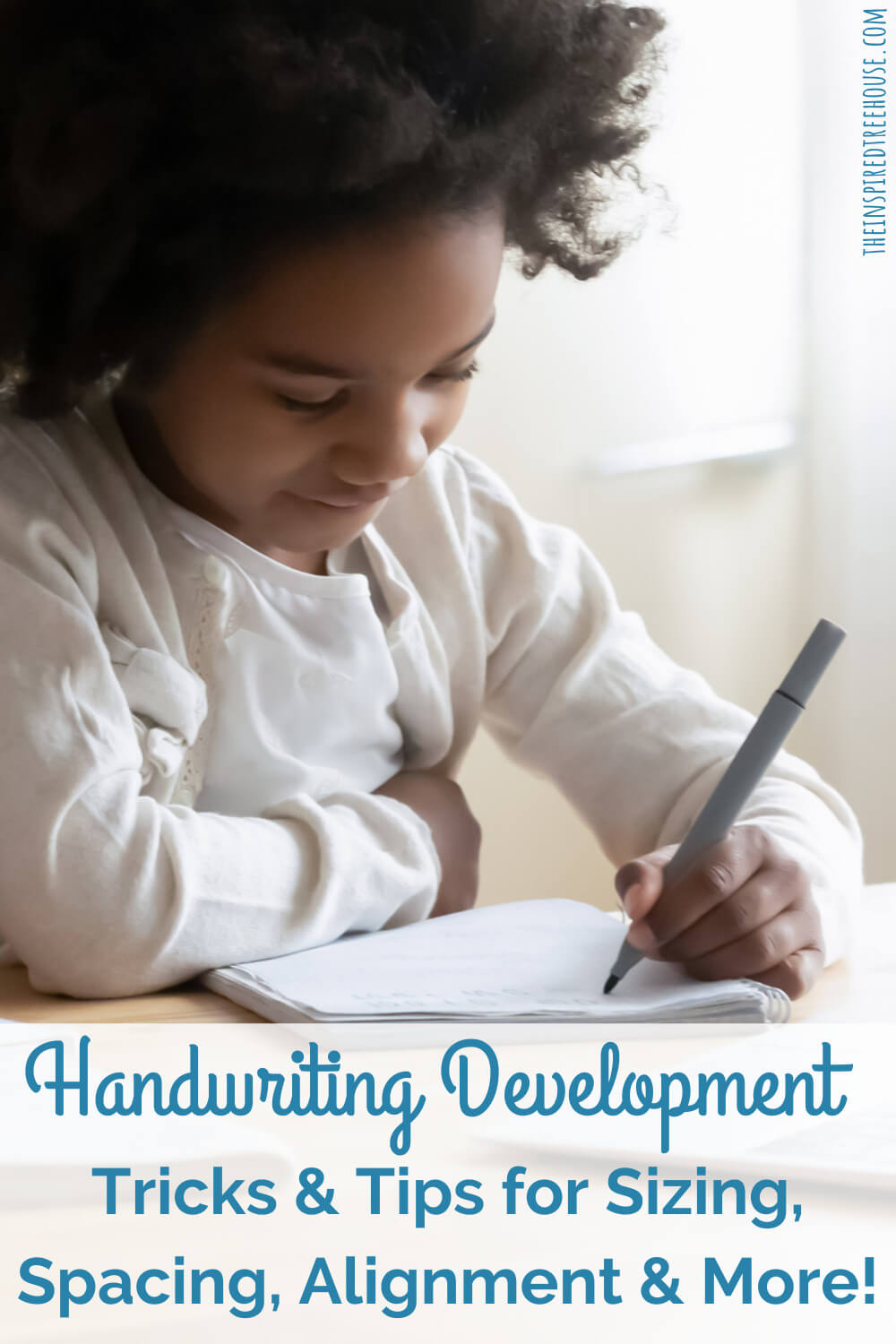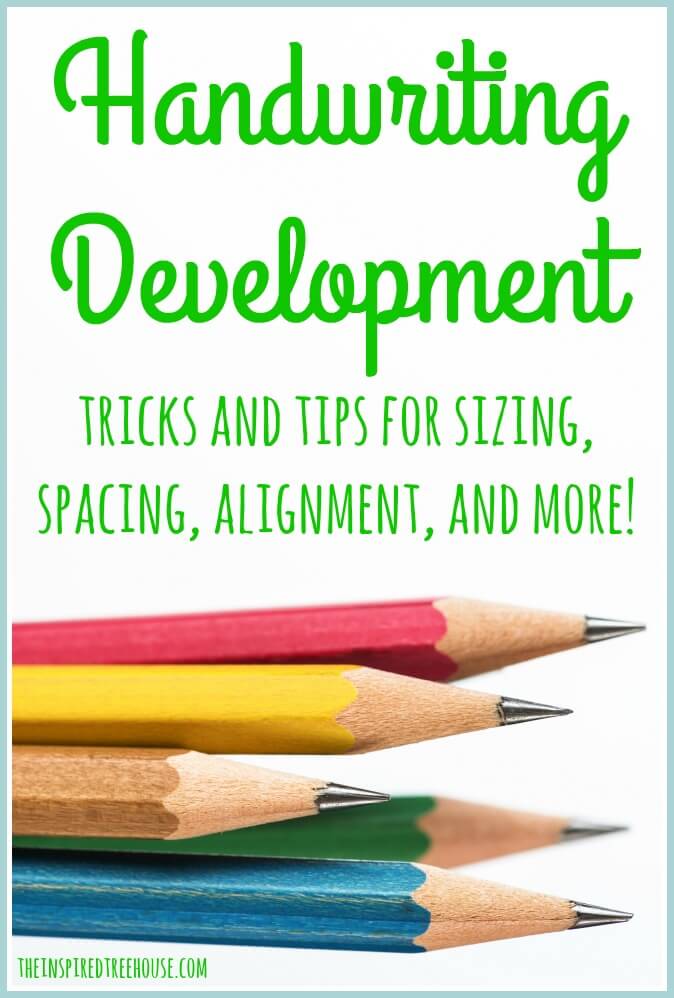Some of the most common questions occupational therapists get from parents and teachers are about tips to improve handwriting.
*This post contains affiliate links. Read more.
Handwriting Development
Handwriting is an extremely complicated skill. We have to have a mental picture or memory of what each letter looks like and then develop a motor plan to create that letter as it looks in our memory. The development of higher level handwriting skills (letter formation, sizing, spacing, alignment, and more) all begins with being able to copy simple shapes. Children who are able to copy basic prewriting shapes are able to copy significantly more letters than those who cannot. 1
Letter Formation and Construction
Once children are able to copy prewriting shapes and lines (horizontal lines, circles, vertical lines, intersecting lines, and diagonal lines) around the ages of 3 to 4 years old, it’s time to move on to letter formation and construction. Sometime during the kindergarten year (between the ages of 5 and 6), kids are ready to learn how to accurately form and construct the letters of the alphabet. 2
Research shows that kids acquire straight-line and circular uppercase letters first, then other uppercase letters, then lowercase letters, numbers, and words (in that order). 3 By the end of first grade, they no longer demonstrate letter reversals in their writing.
In my therapy practice, I differentiate between letter formation (how the letters look) and letter construction (how the child produces each letter). Efficient construction typically leads to better legibility and speed.
Letter Sizing, Alignment and Spacing
After kids have developed accurate letter formation and construction, they need to be able to keep their writing within the designated space on the page…they need to learn how to properly size their letters. During the earliest exposure to handwriting activities, preschoolers and kindergarteners may practice by writing huge letters that take up the whole page. As kids move through kindergarten (ages 5 to 6), they begin to hone this skill and learn how to use the lines on the page to guide the size of their writing. Kids then move on to learn formation and construction of lowercase letters, adding another dimension to letter sizing as they learn about tall, short, and tail letters.
Correct letter sizing closely relates to alignment, or consistent use of the bottom handwriting line as the “home base” or baseline for each letter. This skill also emerges as kids move from kindergarten into first grade (ages 6-7).
As kids become stronger, more confident readers, they begin to have a better sense of where one word ends and the next word begins. This should coincide with the ability to leave appropriate spacing between their words when writing.
Writing Speed
Kids achieve speed and fluency with printing and become more automatic in their writing by the end of second grade (ages 8-9). 1 They are able to keep up with note-taking in the classroom and can complete longer writing assignments (e.g. paragraphs, journals) at an appropriate pace.
Problems With Handwriting Development
Handwriting development can be impacted by many factors, including:
–Attention to task
-Fine motor coordination
-Visual motor integration
-Learning disabilities
When there is a problem in one or more of these areas, children may demonstrate letter reversals beyond the ages of 6-7. They may not be able to keep up with their peers during writing assignments. They may not leave any spaces between their words as they write (or they may leave too much space). They may write with “rollercoaster letters” – the baseline of their letters and words seems to go up and down within the writing lines, like the hills of a roller coaster. Or, they may cover the entire page with huge, giant letters.
Whatever the issue is, there are many strategies and activities for addressing handwriting skills that can help kids compensate for difficulties or help them develop the skills they are lacking.
How to Help: Tips to Improve Handwriting
Letter Formation
–Try letter formation apps like iWriteWords and Little Writer.
–Make “starting points” for each letter using a crayon, marker, or small sticker.
-Try using some fun and exciting writing utensils for kids that make handwriting practice even more fun!
–Use consistent terminology. I use some of the terms from the Handwriting Without Tears program – big line, little line, big curve, little curve, and slide (diagonal line) for the strokes of each letter.
–Use a hands-on approach. Allow children to build letters using Wikki Stix, wooden pieces, or this cool play dough kit. Have kids trace letters cut out of sandpaper or other textured craft paper. Or trace over learning materials with puffy paint or a hot glue gun to make them more touch-friendly!
Alignment tips
–Teach kids the concepts of top, middle, and bottom with movement games. Then, work on generalizing these concepts onto the handwriting paper, by identifying the top, middle, and bottom writing lines.
–Using a highlighter, trace the baseline of his letters on his written work, following along the bottom of each one. It might look like the hills of a roller coaster or the baseline might fall down below the bottom line. Talk about how it looks and how writing is easier to read if the baseline is smooth and flat. Then, highlight the bottom handwriting line on his blank paper before he writes to show him where his baseline should be.
-Try handwriting paper with raised lines or sticking Wikki Stix to the baseline of the handwriting paper to give kids a tactile cue to bump into with their pencils.
Sizing
–Provide a visual and tactile cue by cutting a long rectangular “window” (the same width as the writing lines on the page) out of a strip of cardboard and placing it where the child should write. The window provides a boundary for the child to bump into with his pencil as he writes and a clear visual boundary. This is one of our favorite tips to improve handwriting!
–Handwriting paper with raised lines – Another great tactile cue for kids who tend to make their letters too big.
–Draw boxes for individual letters and gradually move to larger boxes to contain words and then sentences. Worksheets with big, blank spaces are difficult for kids who struggle with sizing and spatial awareness.
Spacing
–Teach the child to place something down in between each word as he is writing. Try popsicle sticks, pennies, small toys or manipulatives – or even the child’s finger.
-I love this Finger Spacer tool and these astronaut spacing tools are adorable too! Or – you could always make your own Space Man spacing tool!
–Draw smiley faces or place small stickers in each space to see how many “points” they can get (1 point for each smiley face).
–Read their writing out loud to them. If they’ve forgotten to leave spaces between words, read it just as it’s written so it sounds jumbled and doesn’t make any sense. It’s a lighthearted way to bring the child’s attention to the fact that his writing won’t make sense without any spaces!
-Try the “Spaghetti and Meatball” handwriting trick from Miss Jamie OT over on the Handwriting With Katherine blog.
Speed and Fluency
–Have kids compete against themselves to beat their time on writing or copying a passage. Tell them not to worry about mistakes or erasing when we’re working on speed – just see if they can get it done as quickly and legibly as possible. Then go back and edit.
–Copy written work from a model. They can sit with a teacher or other adult to generate their own ideas and speak their sentences aloud for the adult to write and then copy the passage from the model.
–Try a fill-in-the-blank format for journals and note taking in the classroom. Preparing a fill-in-the-blank writing prompt doesn’t take long and often helps kids keep up with written tasks.
–Try cursive. Some therapists have reported great luck with moving kids away from printing to learn cursive (even at a young age) to help them improve their writing speed and fluency.
-Try a visual timer on the child’s desk to help keep her focused and on task.
These tips to improve handwriting can be great to try during homework time, in the classroom, or during occupational therapy sessions at school or in the clinic!
Learn more about Assistive Technology Examples for Emergent Writers.

This post is part of the Functional Skills for Kids series. Check out each of the posts about the development of functional skills from The Inspired Treehouse here. And read more about what the other pediatric therapists have to say about functional skills for kids:
Developmental Progression of Handwriting – Mama OT
Fine Motor Considerations of Handwriting – Therapy Fun Zone
Gross Motor and Positioning Considerations for Handwriting – Your Therapy Source
Sensory Considerations for Handwriting – Sugar Aunts
Handwriting: Attention & Behavior Considerations – Kids Play Space
Activities to Extend Handwriting Skills – Growing Hands-On Kids
Visual Perceptual Skill Considerations – Your Kids OT
Handwriting and Play – Miss Jaime OT
1 Feder, K. & Majnemer, A. (2007). Handwriting development, competency, and intervention. Developmental Medicine & Child Neurology, 49
2 Tan-Lin, A. (1981) An investigation into the developmental course of preschool/kindergarten aged children’s handwriting behavior, Dissertation Abstracts International, 42.
3 Weil, M. & Amundson, S. (1994). Relationship between visuomotor and handwriting skills of children in kindergarten. American Journal of Occupational Therapy, 48

Latest posts by Claire Heffron (see all)
- Pro Tips for Conquering Toddler Separation Anxiety - April 25, 2024
- Cute Zipper Bags for Therapists - April 18, 2024
- Fairy Tale Games and Toys - April 12, 2024



[…] Handwriting Development, Sizing, Spacing & More | The Inspired Treehouse […]